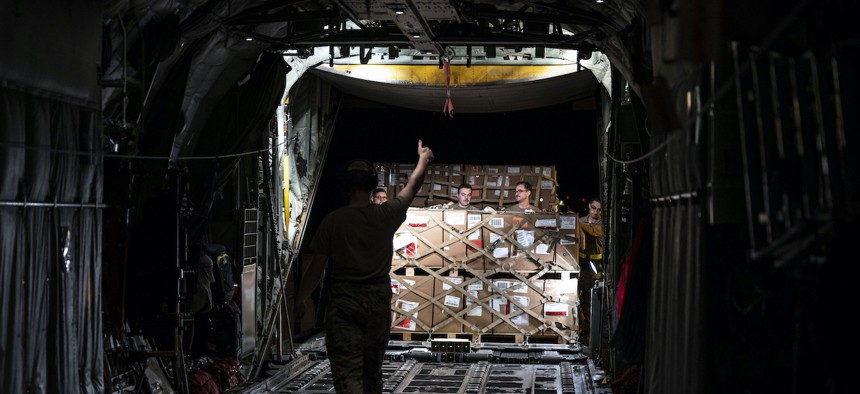
Airmen from the 436th Aerial Port Squadron assist in loading aircraft engine cargo onto a C-130J Super Hercules bound for Africa during a foreign military sales mission at Dover Air Force Base, Delaware, June 24, 2022. U.S. Air Force / Staff Sgt. Marco A. Gomez
Pentagon Wants Combatant Commands More Involved in Foreign Arms Sales
DOD's other ideas to speed up exports include creating a Defense Security Cooperation Service.
The Pentagon wants its regional combatant commands around the world involved more in the sales of U.S. weapons to other countries, U.S. Defense Department officials said.
The move is one of several recommendations made by a “tiger team” looking for ways to speed up the foreign military sales process.
“I think a key…element of the tiger team findings was an understanding that we needed to do more to incorporate the COCOM point of view into the system as it operates here inside the Pentagon and in Washington,” Sasha Baker, defense deputy undersecretary for policy, said at a Tuesday briefing. “Oftentimes, our COCOM commanders, who are closest to the issues and closest to the partners, may be hearing about challenges or timing issues or desire on the part of one partner to sort of maybe reorder their own priorities.”
It’s the latest in a series of moves being explored by the Pentagon and State Department to make the foreign arms sales process quicker. Numerous organizations within the agencies play a role in selling U.S. weapons to other countries, and the White House must propose all foreign military sales and Congress must approve them. The Pentagon acts as sort of a middle man, placing and overseeing allies’ orders from order though delivery—and also sustainment.
The push to speed up foreign sales is not new; the slow pace is a common gripe among defense executives, who say it has lost them sales to China, Russia, and European allies.
Speed has become an extra concern of late as the U.S. and its allies have sought to arm Ukraine against Russia, and is looking to to the same with Taiwan to help fend off a possible invasion by China. Many companies are still experiencing pandemic-related supply chain problems, while assembly lines for key weapons—including munitions—are largely maxed out.
Earlier this month, the Aerospace Industries Association, National Defense Industrial Association, and Professional Services Council made several recommendations to modernize the process, including calling on the government to make quicker policy decisions and create timelines for arms sale so possible sales don’t hang in the balance indefinitely. For instance, an F-35 stealth fighter sale to the United Arab Emirates approved near the end of the Trump administration is still under consideration, despite the Biden administration putting a hold on it in 2021.
The Pentagon on Tuesday said it plans to create a Defense Security Cooperation Service that is similar to the Defense Attaché Service. They also want to “enable efficient reviews for release of technology.”
Officials also want to incorporate allies’ weapons requirements into defense industrial base planning so they know if companies have the capacity to manufacture the correct weapons.
“This will include developing a comprehensive study to incentivize [defense industrial base] investment in production capacity and building surge capability for high-demand, low-supply platforms, systems, and services,” the Pentagon said in a statement. “The strategy will include use of multi-year contracts; enhanced use of the Special Defense Acquisition Fund; five-year predictive analyses of partner demand; and sustained engagement with the DIB.”
AIA CEO Eric Fanning called the Pentagon tiger team’s recommendations “an important step in the modernization of the foreign military sales system. Now the work of immediate implementation begins—and industry is ready to get started today.”
These efforts come as the U.S. and its allies have sped billions of dollars worth of weapons to Ukraine to defend against a Russian invasion. But in most cases involving Ukraine, the weapons came from U.S. and ally stockpiles, allowing them to be transferred quickly.


